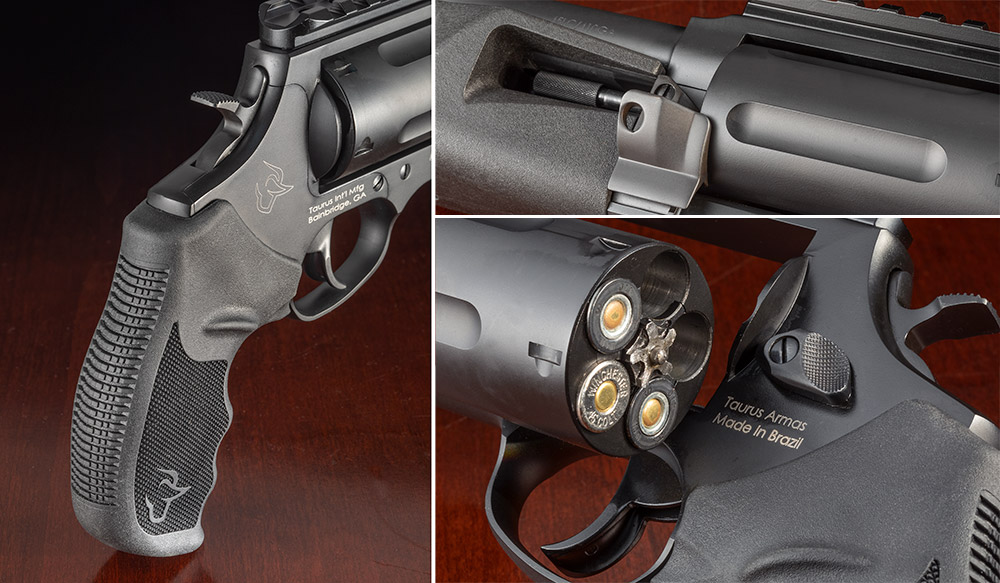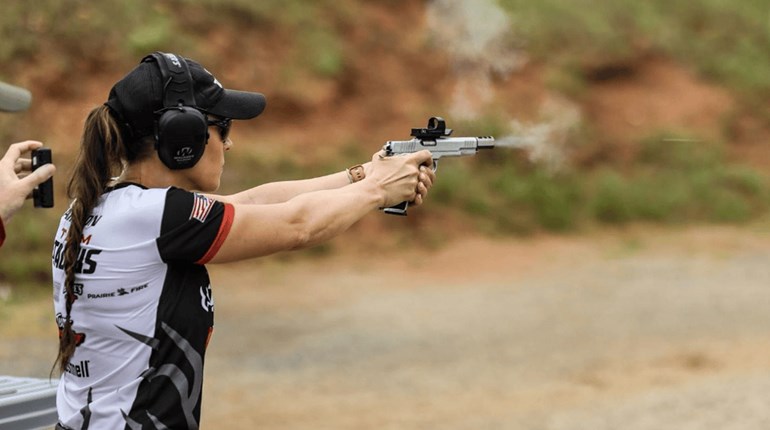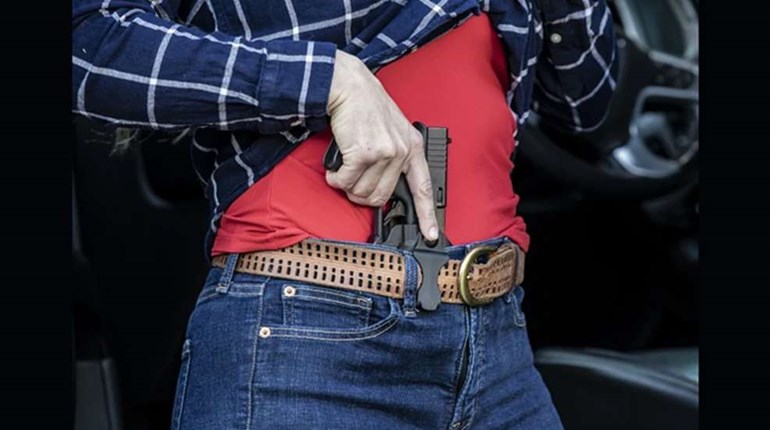
Sometimes, the best tool for the job takes an unorthodox form, as you can see with the Taurus Judge Home Defender, a 20-inch revolver that shoots both .45 Colt and .410 shotshells. Could this unconventional revolver dethrone the average pistol in the role of home protection? Well, after spending some time on the range with it, I think it fares a chance.
For starters, you can hold and fire it like a traditional revolver, which you might not expect from looking at the gun’s pronounced fore-end. Although the barrel is 13 inches long, it is cut to a thin profile, which balances the gun. And, although grabbing a wheel gun forward of the cylinder when firing would typically injure the user, the Home Defender borrows blast-shield technology from its cousin, the Circuit Judge, so you can support the gun more if you need to do so. The Judge Home Defender also sports a four-slot Picatinny rail that is perfect for a laser, allowing accurate shot placement from a third holding position—the hip. (The rail might tempt you to clamp on a forward grip, but doing so would turn this, or any, handgun into an NFA item subject to additional government controls, so I advise against it.) The one-piece rubber grip uses soft-textured crosshatching and a gently serrated backstrap. On the front side of the grip are mild finger grooves that I found best accommodate medium or larger hands.

The Home Defender surprisingly doesn’t come with any sort of sighting system, though it includes a notched Picatinny rail, so a bead would have been easy to add. I affixed a Sightmark Mini-Shot M-Spec red-dot optic to the rail, as it includes a Picatinny adapter for easy installation. This tiny optic features a top-mounted solar panel, which saves your battery, assuming you aren’t shooting in pitch-black conditions.
 Like other revolvers in the Judge family, the Home Defender is chambered to fire both .45 Colt and .410 shotshells; however, Taurus wisely built this one with three-inch chambers. Three-inch shells do fit into the two-and-a-half-inch-chambered Judges; however, if you actually fire three-inch shells in them, the crimp rolls into the forcing cone, locking the cylinder in place and disabling the gun. The Home Defender’s three-inch chambers neatly avoid the problem.
Like other revolvers in the Judge family, the Home Defender is chambered to fire both .45 Colt and .410 shotshells; however, Taurus wisely built this one with three-inch chambers. Three-inch shells do fit into the two-and-a-half-inch-chambered Judges; however, if you actually fire three-inch shells in them, the crimp rolls into the forcing cone, locking the cylinder in place and disabling the gun. The Home Defender’s three-inch chambers neatly avoid the problem.
The duality of ammunition choices greatly expands the role of the Home Defender. While buckshot is perfect for emergency use, the gun’s .45 Colt chambering makes it easy to practice with and, with the right load, fun. But, at the time of this writing, we really had to scrounge to find any. Being that I had one box of SIG 230-grain V-Crown at my disposal, I chose this to zero the optic and develop a general feel for the firearm. For accuracy testing, I grabbed Fiocchi’s Range Dynamic ammo and paired it with Black Hills solid-lead cowboy load. Both are designed for low-cost shooting, with the Black Hills load being built for the softest-recoil pulse possible in this chambering. As I wanted to know how it patterned, I chose two uniquely different shotshells for that portion of the test. The first was Hornady’s Triple Defense load, as it was built explicitly for firearms of this nature. Stuffed with three pieces of lead, a smooth-bodied .41-caliber slug leaves the barrel first, followed by two .35-caliber round balls. Being that the slug engages the Judge’s rifling, it flies straighter than the other two projectiles. Our second round was Remington’s Ultimate Defense, which is stuffed with four conventional 000-buckshot pellets. By the numbers, this shell will have a wider dispersion.
I have to say, for a standard trigger, the Judge Home Defender’s was quite clean. With the hammer cocked, it only took about six pounds of pressure to break, and when it did, it was free of creep and overtravel. The double-action trigger press took more force, of course, but it wasn’t unbearable and was consistent throughout its entire stroke. SIG’s load had punch, but the weight of the Home Defender soaked up most of the recoil. I found outstanding accuracy from the remaining loads. I didn’t expect that level of accuracy from a firearm of this nature, but, since the barrel is over a foot long, I should have had an inkling.
Firing the shotshells was an interesting experience, as the Hornady load exceeded its advertised speed, while the Remington shells fell below the number on the box. That’s not a function of quality, but rather of intended purpose. Remington’s load was developed and measured with a shotgun-length barrel; Hornady made its for a handgun. Nonetheless, both produced excellent results. No pellets strayed outside our 21-inch test metric, and darn near every pattern was perfectly centered. (Having an impeccably zeroed red-dot played a big part in this, so I’m slowly becoming a believer in electro-optics.)
I ended the day with hip shooting and firing from compromised positions to showcase the revolver’s advantages over long guns in these scenarios. To be honest, much of this was in the name of sheer entertainment, as the Home Defender was just a whole lot of fun to shoot. This brings me to my closing point: Your home defense tool ought to be fun to use; if it is not, you’ll never seem to find the time to practice with it. Far too often, I see folks buy firearms that are painful to shoot or expensive to feed for home-defense use, and, sadly, after their initial training, they never pick up the gun again. The Taurus Judge Home Defender is built for fun as well as purpose, so I’ll likely find myself picking it up more frequently.


































